The Spring[1] (スプリング[2], Supuringu?), also referred to as the Jump Spring (ジャンプバネ, Janpu Bane?) and the Springboard,[3] is a gimmick that appears in the Sonic the Hedgehog series. They are utilized by the player to bounce the playable character in a given direction, often for the purpose of reaching otherwise unreachable places or building up huge amounts of running speed in short time.
Springs originally made their debut as simple red and yellow platforms but have since taken on a more distinct design over the course of the Sonic series.
Description
The Spring allows the playable characters to launch themselves through midair or along the ground. Once a playable character makes contact with a Spring's broad side, they are instantly flung a certain distance in the direction the Spring is facing. Because a Spring can be aimed in virtually any direction, there are no trajectory the playable characters cannot be flung along (unless something is blocking the path). The Springs are therefore very useful whenever the player needs to traverse a level. They can for example help a player across a gap, nudge the characters towards a certain spot, help the player reach places and items that are otherwise out of their reach, or take the character down a predetermined path. In fact, it is not uncommon for Springs be aligned so that the player will be send from one Spring to the next whenever the player needs to follow a path they cannot traverse on their own. The player usually has to jump onto the Spring's broad side to be launched, although they can bounce off Springs by simply touching them in later games. From the 3D games and onwards, the Springs can also be _targeted with the Homing Attack.
The control the player can exert over their flight path when sent flying by a Spring vary. In some situations, especially in the early games or when using the "classic" Springs, the playable characters can still move left or right when being bounced directly upwards by a Spring. In other situations, especially when using the "modern" Springs, the player usually cannot control their movements in midair at all, as the Spring manually guides the player to another section, or at least until after the player reaches the apex of their bounce in some cases.
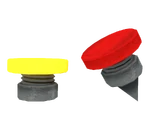
In early Sonic games, Springs are presented as red or yellow disk-shaped panels with a gray-colored spring underneath them. When they later made their debut in 3D games such as Sonic Adventure, the Springs' panels were shaped more like flat hemispheres, which have red edges and a gold star in the middle of a blue circle emblazoned on top of them, and gray/red springs underneath them. As the 3D installments went on, the Spring panels became rounder in shape and occasionally gained blue/yellow edge lines. Only a few games, such as Sonic Adventure 2 and Sonic Generations, reveal that Springs have pointy ends underneath their spring panels. Springs can also be found floating in mid-air with the aid of propellers (such as Propeller Springs) or without them. Over the course of the series, there have also been several other gimmicks based on the Springs.
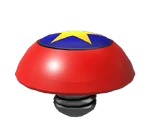
In the early installments, red Springs propel the player a high distance into the air, while yellow ones only send the playable character a medium to low distance into the air. Some Springs are also hidden beneath a surface and will only appear when the character moves over them. Springs are usually aligned horizontally, vertically or diagonally, especially in the 2D/2.5D games. While the player can get launched into mid-air by vertical and diagonal Springs, horizontal types bounce the player backwards, thereby giving them extra running speed. Certain sections of the Zones can also have pits of Springs or corridors with diagonal-pointing Springs. Some Springs can also have floating strings of Rings along the paths they send the playable characters.
There are Zones like Spring Yard Zone and Spring Stadium Zone that feature Springs as the main gimmicks. Some enemies throughout the Sonic series also use Springs to defend themselves.
Game appearances
Sonic the Hedgehog (1991)
![]() In the 16-bit version of Sonic the Hedgehog (1991), and its numerous ports and remasters, the Springs,[4] alternatively spelled as springs,[5] and also known as Springboards,[4] are introduced. In gameplay, they appear in every Zone except Final Zone. They are either horizontally or vertically aligned. Two variants of the Springs are also featured: the yellow springs,[5] which only bounce the player a small distance into midair; and the red springs,[5] which bounce the player higher into midair. Additionally, in Green Hill Zone, Springs can appear hidden on top of palm trees.
In the 16-bit version of Sonic the Hedgehog (1991), and its numerous ports and remasters, the Springs,[4] alternatively spelled as springs,[5] and also known as Springboards,[4] are introduced. In gameplay, they appear in every Zone except Final Zone. They are either horizontally or vertically aligned. Two variants of the Springs are also featured: the yellow springs,[5] which only bounce the player a small distance into midair; and the red springs,[5] which bounce the player higher into midair. Additionally, in Green Hill Zone, Springs can appear hidden on top of palm trees.
In the 8-bit version, both variants of the Springs are featured. In this game, the Springs are referred to as Springboards.[6] The game also exclusively presents three variants of Springs in the game's Special Stages, each of which let Sonic bounce a different height: green Springs bounces the highest, yellow Springs medium heights, and purple Springs the lowest of all three.
Sonic the Hedgehog 2
8-bit
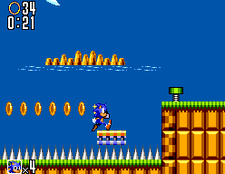
In the 8-bit version, the Springs retain their classic design. They are also either horizontally, vertically or diagonally aligned.
Due to the palette limitations in the game, the game only has regular Springs which come in multiple colors, such as yellow, green, pink and gray. However, they all exhibit the same bouncing strength.
16-bit
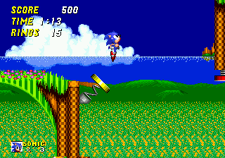
In Sonic the Hedgehog 2, the Springs possess their classic design. In this game, horizontally and diagonally aligned red and yellow Springs appear. Additionally, the game introduces for the first time diagonally aligned Springs which let the player bounce diagonally into the air, and Springs hidden in the ground.
Like in the previous game, many of the game's Zones make their own use of the Springs and their mechanics thoughout the adventure. When the playable characters exit a high-speed warp tube in Chemical Plant Zone for example, the tube's cover shuts down and protrudes a small red Spring. There are also Jump Panels and Spring Catapults in Casino Night Zone and steam pipes in Metropolis Zone, all of which function similarly to the Springs by sending the player flying through the air.
SegaSonic the Hedgehog
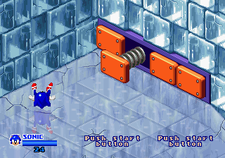
In SegaSonic the Hedgehog, the Springs forego their classic design. Instead, they are designed as horizontally aligned Springs with square orange panels. In this game, they only appear in Icy Isle.
In gameplay, Icy Isle has pathways where the walls are lined with Springs. If the player touches these Springs' broad side, the playable character will be bounced back a small distance.
Sonic the Hedgehog CD
![]() In Sonic the Hedgehog CD, the Springs possess their classic design. In this game, horizontally, vertically and diagonally aligned red and yellow Springs appear. Noticeably, when bouncing on a vertical Spring this time around, the playable character will twirl around himself in midair. Horizontal Springs can also be useful for using the Time Warp, especially when there are two of them pointing towards each other.
In Sonic the Hedgehog CD, the Springs possess their classic design. In this game, horizontally, vertically and diagonally aligned red and yellow Springs appear. Noticeably, when bouncing on a vertical Spring this time around, the playable character will twirl around himself in midair. Horizontal Springs can also be useful for using the Time Warp, especially when there are two of them pointing towards each other.
Palmtree Panic and Metallic Madness feature unique red Springs attached to small wheels which move back and forth, usually in sections with holes in the roofs. Collision Chaos also has arenas full of vertical Springs, and certain horizontal Springs will pop up from behind to give the playable character an extra boost of speed on steep ramps. Stardust Speedway also features floating launchers for shooting the playable characters through midair that incorporate the red Spring. Red Springs, called Spring Blocks,[7] appear in several Special Stages as well.
Sonic Chaos
![]() In Sonic Chaos, the Springs possess their classic design. In this game, vertically aligned yellow and red Springs are usually hidden underground. Only the red Springs are aligned horizontally, though vertically and diagonally aligned Springs appear in the Special Stages as well.
In Sonic Chaos, the Springs possess their classic design. In this game, vertically aligned yellow and red Springs are usually hidden underground. Only the red Springs are aligned horizontally, though vertically and diagonally aligned Springs appear in the Special Stages as well.
Sonic Chaos introduces the Pogo Spring power-up that equips the player with a movable Spring to bounce around with. Enemies like the Bane Motora, Frogger or the Great Bane Motora Gold also have Springs equipped for their own use, usually for defense.
Sonic 3 & Knuckles
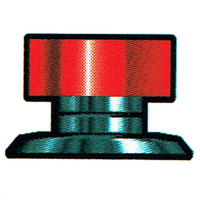
In Sonic the Hedgehog 3, Sonic & Knuckles, and the lock-on game Sonic 3 & Knuckles, the Springs feature their classic design. In this game, yellow and red Springs are horizontally, vertically and diagonally aligned. Vertical Springs in particular can be hidden underground or inside breakable obstacles.
In the Gumball Machine Bonus Stages, red Springs on the bottom of the stage's corridor disappear after being used once, but will reappear after collecting green Gumballs. Also, in the Competition mode, red Springs appear inside floating bubbles along the course. Tagging this bubbled item will make a Spring drop onto the course to catapult careless runners off their course.
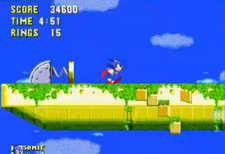
Like in previous games, these titles use the Springs and their mechanics in different ways for certain Zones. One section of Sky Sanctuary Zone for example has Springs that come out of the ground to bounce the player back down the path they just came running down of; these Springs later reappear in Death Egg Zone.
Sonic Drift series
Sonic Drift
![]() In Sonic Drift, the Springs possess their classic design and are all colored yellow. This particular gimmick is also referred to as the Jump Spring (ジャンプバネ[8], Janpubane?).
In Sonic Drift, the Springs possess their classic design and are all colored yellow. This particular gimmick is also referred to as the Jump Spring (ジャンプバネ[8], Janpubane?).
In gameplay, the Springs appear on the racing courses and will send the user spinning forward through the air for few seconds, allowing them to pass over opponents and increase their speed a bit. In addition, they nullify any power-up the user may have in effect at the moment.
Sonic Drift 2
![]() In Sonic Drift 2, the Springs possess their classic design and are all colored red. Additionally, this gimmick is renamed the Spring[9] (ジャンプバネ[10], Janpubane?, lit. "Jump Spring") this time around.
In Sonic Drift 2, the Springs possess their classic design and are all colored red. Additionally, this gimmick is renamed the Spring[9] (ジャンプバネ[10], Janpubane?, lit. "Jump Spring") this time around.
In gameplay, the Springs appear on the racing courses and function basically like they did in the previous title: they send the user flying through the air for a few seconds while nullifying any power-up they have in effect. There is also the Jump power-up which lets the playable characters launch themselves through the air like the Springs.
Sonic Triple Trouble
![]() In Sonic the Hedgehog Triple Trouble, the Springs possess their classic design. In this game, vertically aligned yellow and red Springs are almost always hidden underground, while horizontally and diagonally aligned Springs appear normally. The Pogo Spring power-up also makes a return.
In Sonic the Hedgehog Triple Trouble, the Springs possess their classic design. In this game, vertically aligned yellow and red Springs are almost always hidden underground, while horizontally and diagonally aligned Springs appear normally. The Pogo Spring power-up also makes a return.
In addition to the game's normal Zones, Springs also appear in the game's Special Stages. The Springshell Badniks in Great Turquoise Zone likewise have Springs on their backs. Additionally, there is the Flying Spin Attack which both Sonic and Tails can perform after they get bounced into midair by Springs.
Knuckles' Chaotix
![]() In Knuckles' Chaotix, the Springs possess their classic design. In this game, horizontally, vertically and diagonally aligned Springs are featured regularly. In addition to the red and yellow Springs, this game also presents blue Springs which grant bounces even higher than those the red ones permit. Using Springs in this game can be difficult, however, due to the Ring Power, but it is possible to carry the Combi partner to make the usage of them easier.
In Knuckles' Chaotix, the Springs possess their classic design. In this game, horizontally, vertically and diagonally aligned Springs are featured regularly. In addition to the red and yellow Springs, this game also presents blue Springs which grant bounces even higher than those the red ones permit. Using Springs in this game can be difficult, however, due to the Ring Power, but it is possible to carry the Combi partner to make the usage of them easier.
In the game's Bonus Stages, red and yellow Springs are set on cubic blocks. Each time these Springs are hit (which results in the playable character being bounced upward), they crack, and after three hits, the blocks become broken, rendering the Springs unusable.
Tails Adventure
![]() In Tails Adventure, the Springs possess their classic design. In this game, stages such as Poloy Forest, Cavern Island and Green Island feature blue Springs which the player can use to backtrack. Tails can also push these Springs along the ground in any direction to determine the location of the bounce.
In Tails Adventure, the Springs possess their classic design. In this game, stages such as Poloy Forest, Cavern Island and Green Island feature blue Springs which the player can use to backtrack. Tails can also push these Springs along the ground in any direction to determine the location of the bounce.
Sonic Labyrinth
![]() In Sonic Labyrinth, the Springs are entirely orange with a cylinder-shaped form when compressed. Also, instead of a spring for propulsion, they have a mechanized extension. In this game, they only appear in the Labyrinth of the Sky and the Labyrinth of the Castle.
In Sonic Labyrinth, the Springs are entirely orange with a cylinder-shaped form when compressed. Also, instead of a spring for propulsion, they have a mechanized extension. In this game, they only appear in the Labyrinth of the Sky and the Labyrinth of the Castle.
Sonic 3D Blast
![]() In Sonic 3D Blast, the Springs possess their classic design. In this game, the typical Springs are all red and usually come in two types. The single types are placed under floating Sonic Medals, though the player must sometimes have Flickies in their possession to reach some of these medals. The other type of Springs are hidden underground and appear most commonly in Spring Stadium Zone.
In Sonic 3D Blast, the Springs possess their classic design. In this game, the typical Springs are all red and usually come in two types. The single types are placed under floating Sonic Medals, though the player must sometimes have Flickies in their possession to reach some of these medals. The other type of Springs are hidden underground and appear most commonly in Spring Stadium Zone.
Diamond Dust Zone contains rare, horizontal blue Springs on the walls that can send Sonic into a backwards roll. The Zone also has red Springs that are covered in snow drifts that must be broken to reveal said Springs. In the Sega Saturn version of Sonic 3D Blast, there are also pairs of red Springs along the half-pipe routes of the Special Stages. These red Springs let the player bounce into the midair to catch Rings or reach higher platform routes. Notably, for the first time in the Sonic the Hedgehog series, the Springs' panels are in this game emblazoned with a gold star in the middle of a blue circle. This design would become a mainstay for the Springs in future games.
Sonic Blast
![]() In Sonic Blast, the Springs possess their classic design. In this game, the Springs are all red and are all notably smaller. In gameplay, they appear in both the regular Zones and the Special Stages.
In Sonic Blast, the Springs possess their classic design. In this game, the Springs are all red and are all notably smaller. In gameplay, they appear in both the regular Zones and the Special Stages.
Sonic R
In Sonic R, the Springs possess their classic design. In this game, red Springs appear in Regal Ruin and Reactive Factory where they help the player reach the other side of local pits or scale hills and cliffs.
Sonic Adventure
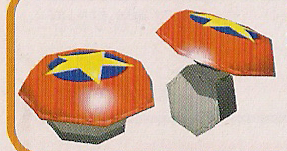
In Sonic Adventure and its enhanced port Sonic Adventure DX: Director's Cut, the Springs received their modern design for the first time as a part of the game's redesign. This design was used by every Spring in the game. They were also renamed "Spring Bumpers".[11]
In this game, the Springs appear as common gimmicks in the Action Stages. Also, in gameplay, the Springs can shoot the player in any direction, unlike earlier Springs, which can only be aimed horizontally, diagonally, and vertically. However, the player cannot control their movements in midair when they are sent flying by a Spring in this game, as they manually guide the player to another section.
In addition to Springs, Sonic Adventure introduces the uncommon Wide Spring, which is a gimmick where three Springs are aligned next to each other.
Sonic Shuffle
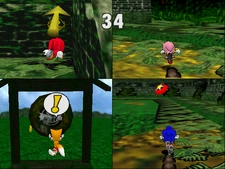
In Sonic Shuffle, the Springs possess their modern design. In this game, Springs appear if the player lands on a Jump Space on a Board. Using this Spring will bounce the playable character to another Space on the Board.
The VS 4 Mini-Game, Sonic Tag, also features Springs, which appear in two corners. Hitting one of these Springs will bounce the characters to the top of the Mini-Game's pyramid.
Sonic Adventure 2
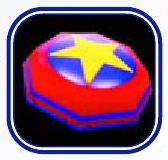
In Sonic Adventure 2 and its enhanced port Sonic Adventure 2: Battle, the Springs possess their modern design, though this game's particular design also includes two blue lines along the Springs' edges. In gameplay, they also work similarly to how they did in Sonic Adventure. Generally, the player do not want to mess with the trajectory of a Spring or they risk falling off-course to their doom.
In this game, the player is introduced to another variant of the Spring: the Propeller Spring. Additionally, there are the Spring Beetle enemies that have Springs attached to them, which make them virtually invulnerable. By using Mystic Melody, the player can also summon Springs on top of or near Ancient Ruins.
In the unlockable Green Hill stage, Springs have their original sound effect from the original Sonic the Hedgehog when the player bounces on them.
Sonic Advance series
Sonic Advance
![]() In Sonic Advance, the Springs boast a distinguished design. These Springs have panels similar to the classic Springs', except these Springs' panels have more outward-pointed edges. They also have the bumper's symbol emblazoned on top of them.
In Sonic Advance, the Springs boast a distinguished design. These Springs have panels similar to the classic Springs', except these Springs' panels have more outward-pointed edges. They also have the bumper's symbol emblazoned on top of them.
In this game, horizontally, vertically and diagonally aligned red and yellow Springs appear. The yellow Springs in particular cannot launch the player as high up as the red Springs, like in earlier games. Also, the player has to leap onto the broad side of the Springs in order to use them.
Hitting a Spring with a Hammer Attack in this game will result in the playable character being catapulted higher than the Springs are normally capable of. This game also introduces the Special Springs, which the player can use to enter the Special Stages.
Sonic Advance 2
![]() In Sonic Advance 2, the Springs boast another distinguished design. These Springs have panels with sharp edges and the bumper's symbol emblazoned on top of them.
In Sonic Advance 2, the Springs boast another distinguished design. These Springs have panels with sharp edges and the bumper's symbol emblazoned on top of them.
In this game, horizontally, vertically and diagonally aligned red Springs primarily appear. Also, in gameplay, unlike the Springs in Sonic Advance, the player can use the Springs by simply running into them. Also, when setting off from Springs, the player can pull off Mid-Air Trick Actions. In addition, like in Sonic Advance, hitting a Spring with a Hammer Attack will result in the playable character being catapulted higher than the Springs are normally capable of.
Exclusive to Sonic Advance 2 are dark blue variants called Blue Plungers[12] or Blue Springs,[12] that let the player bounce higher by pressing ![]() then releasing it as the playable characters jumps. Music Plant also has Hi-hats which work much like Springs. Also, in mini-game of Chao Garden, Cream uses a mobile Spring on wheels to bounce Cheese into midair so it can gather Rings.
then releasing it as the playable characters jumps. Music Plant also has Hi-hats which work much like Springs. Also, in mini-game of Chao Garden, Cream uses a mobile Spring on wheels to bounce Cheese into midair so it can gather Rings.
Sonic Advance 3
![]() In Sonic Advance 3, the Springs underwent another redesign. This time around, the Springs have thick panels with soft edges and the bumper's symbol emblazoned on top of them.
In Sonic Advance 3, the Springs underwent another redesign. This time around, the Springs have thick panels with soft edges and the bumper's symbol emblazoned on top of them.
In this game, only horizontally, vertically and diagonally aligned red Springs appear. Additionally, in gameplay, the player can simply run into the Springs in order to use them, like in Sonic Advance 2. Also, the player can execute Mid-Air Trick Actions when they set off from Springs. In addition, like in Sonic Advance, hitting a Spring with a Hammer Attack will result in the playable character being catapulted higher than the Springs are normally capable of.
Besides the regular Springs, the game also features the Special Springs which let the player enter Special Stages. Exclusively to this game are also special flatten Springs that only become usable for a short time by pressing a nearby Switch. Also, in the Chao Garden mini-game, Cream uses a mobile Spring on wheels to bounce Cheese into midair so it can gather Rings.
Sonic Heroes

In Sonic Heroes, the Springs possess their modern design, although their design is more bulky this time around.
In this game, regular Springs do not appear as often as the Wide Springs due the gameplay revolving around team mechanics. They are also usually found in or locked inside of a case, which can only be opened after defeating the enemies surrounding them.
Shadow the Hedgehog
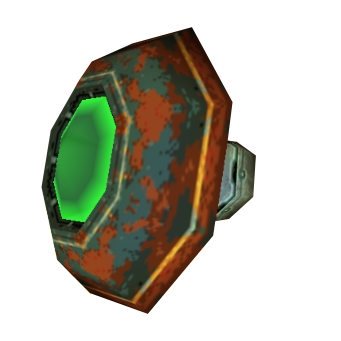
In Shadow the Hedgehog, the Springs are given a redesign that fits the game's dark atmosphere. Being based on the modern Springs, they are tinted with a darker shade of red and slight rust, and have a green-glowing center on top of them. Despite the altered look though, the Springs function just like they did in Sonic Heroes.
Sonic Rush series
Sonic Rush
![]() In Sonic Rush, the Springs possess a design similar to their modern one, except their panels this time are thicker and rounder. In this game, the Springs are a common and often vital object. They are usually aligned either horizontally, vertically or diagonally, though many of them are mostly set in tight roof corners.
In Sonic Rush, the Springs possess a design similar to their modern one, except their panels this time are thicker and rounder. In this game, the Springs are a common and often vital object. They are usually aligned either horizontally, vertically or diagonally, though many of them are mostly set in tight roof corners.
In gameplay, when the playable character is sent into the air by Springs, the player can perform Trick Actions. Night Carnival also features blue Springs, which give 200 points automatically, and Spring blocks, which can be charged by pressing down on ![]() and releasing it at the right time for extra airtime. The Special Stages also features the Trick Spring that Sonic can set off from in order to initiate Ring-granting Real-Time Interactions.
and releasing it at the right time for extra airtime. The Special Stages also features the Trick Spring that Sonic can set off from in order to initiate Ring-granting Real-Time Interactions.
Sonic Rush Adventure
In Sonic Rush Adventure, the Springs look exactly like they did in Sonic Rush, being thicker and rounder versions of modern Springs. Like in Sonic Rush, Springs in this game are either horizontally, vertically or diagonally aligned, though many of them are mostly set in tight roof corners.
In gameplay, the Springs allow the player to perform Trick Actions when bouncing off them, like in the previous title.
Sonic the Hedgehog (2006)

In Sonic the Hedgehog (2006), the Springs all possess their modern design, but with a few more details added to their appearance, such as a blue ring around their center and gray rims.
In this game, Springs are normally aligned vertically or diagonally. Like in Sonic Heroes, some of the Springs are locked in Cases that can only be opened after defeating all of the enemies surrounding it. Curiously, when using a Spring in this game, the playable characters will bounce, but the Spring will not move. It also does not bounce the player, but instead repeats its animation.
Sonic Rivals series
Sonic Rivals
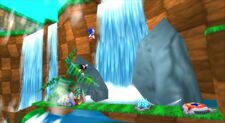
In Sonic Rivals, the Springs are given a new look, having been redesigned as flat white plates with a red spring panel, a yellow circle in the middle and a blue star at the center. Their springs are likewise bright. Otherwise, they function like the Springs in previous games. Also, all of the Springs are aligned either horizontally, vertically or diagonally.
Sonic Rivals 2
In Sonic Rivals 2, the Springs possess the same look they had in Sonic Rivals. As such, they each consist of a flat while plate with a red and yellow spring panel in the middle, a bright spring, and a blue star at in the center. Like in Sonic Rivals, the Springs also work just like any other Spring despite their look and are aligned either horizontally, vertically or diagonally.
The Spring also appears on collectible cards:
| Image | Card Number | Card | Challenge | Unlocked |
|---|---|---|---|---|
 |
31 | Spring | Successfully Air Boost 100 times | N/A |
 |
32 | Spring | Successfully Air Boost 300 times | N/A |
 |
33 | Spring | Successfully Speed Boost 25 times | N/A |
Sonic Storybook Series
Sonic and the Secret Rings
In Sonic and the Secret Rings, the Springs possess their modern design, albeit with a few details added to them to give the Springs a look befitting the world of the Arabian Nights, like a different hue of colors and a yellow line along their rim. In this game, Springs usually appear along or at the end of Grind Rails or on walls. The game also introduces the Thorn Springs, a variant of the Springs which can damage Sonic if he touches them at the wrong time
Sonic and the Black Knight
In Sonic and the Black Knight, the Springs possess their modern design. In this game, Springs and Wide Springs appear on a few occasions during missions, particularly in the Legacy Missions, but are otherwise replaced by blue fairies. In addition, the player can _target Springs with the Homing Dash. Also, whenever the player uses a Spring, they earn "Jump Bonus" points.
Sonic Unleashed
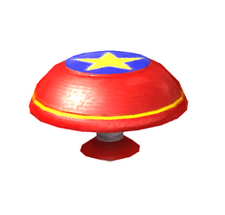
In both the Xbox 360/PlayStation 3 and the Wii/PlayStation 2 version of Sonic Unleashed, the Springs possess their modern design. This time however, their modern design is more round and has a yellow line around the edge of their panels. Certain Springs also have white bases under their panels. Additionally, the Springs are referred to as Springboards on the Xbox 360/PlayStation 3 version.[3][13]
In this game, the Springs only appear in the daytime levels where Sonic the Hedgehog is playable. The game also introduces several new variants of the regular Spring: Egg Springs, which are meant to knock the player off-course, Springs which float in midair thanks to propellers on their bottom, and blue springs, which initiate a Real-Time Interaction when the player bounces off them.
Besides appearing in gimmick form, two Egg Fighter varieties in the game come equipped with Springs: the Egg Fighter: Knight and Egg Fighter: Shield. Both of these enemies wields a shield equipped with a Spring that can repel Sonic.
Sonic the Hedgehog 4
Episode I
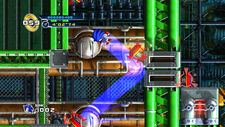
In Sonic the Hedgehog 4: Episode I and its later addition, Sonic the Hedgehog 4: Episode Metal, the Springs possess their modern design. Like in Sonic Unleashed, the Springs also have a yellow line around the edge of their panels.
In this game, the Springs are common gimmicks and are aligned either horizontally, vertically or diagonally. Typically, the Springs are located close to a string of Bubbles for midair traversing. Like in other 3D games, Sonic is also able to _target the Springs with the Homing Attack.
Episode II
In Sonic the Hedgehog 4: Episode II, the Springs, like in Sonic the Hedgehog 4: Episode I, possess their modern design, but with a yellow line around the edge of their panels added to it.
In this game, the Springs are again common gimmicks. Aligned either horizontally, vertically or diagonally, the Springs are typically located close to a string of Bubbles for midair traversing. Like in the 3D games, the player can also _target the Springs with the Homing Attack. Like in earlier games, the Springs and their mechanics are also used in different ways in certain Zones: Sylvania Castle Zone features Flip Platforms, which the player can use the Homing Attack on to reveal a Spring on their bottom, and White Park Zone Act 2 has Springs that bounce the player between routes that run parallel to each other.
Sonic Colors
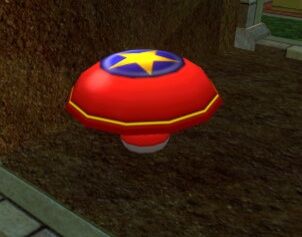
In both the Wii version and Nintendo DS version of Sonic Colors, and the remaster Sonic Colors: Ultimate, the Springs make an appearance as common gimmicks.
In the Wii version and Sonic Colors: Ultimate, the Springs possess their modern design, but with a yellow line around the edge of their panels added to them. Along with the return of the Trap Springs and Wide Springs, the game also introduces the new mobile spring which moves around in accordance to the playable character's movements.
In the Nintendo DS version, the Springs possess their modern design as well, except the panels on these Springs are thicker and rounder, like those in the Sonic Rush games. On this version, the Springs are aligned either horizontally, vertically or diagonally. Like in Sonic Rush, the Special Stages have Springs as well, albeit for reaching Spheres this time. This version also introduces the multiplayer mode-exclusive Spring Item Box power-up, which lets the player place a Spring in their opponent's path that will shoot the player towards the left side of the screen.
Sonic Generations
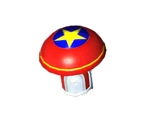
In the console/PC version and Nintendo 3DS version of Sonic Generations, the first Act of all the Stages feature only the classic yellow and red Springs from the early Sonic games (with all of their mechanics intact), while the second Act of the Stages only feature the standard modern Springs from the post-Sonic Adventure games. The modern Springs in particular have a yellow ring around the edge of their panels, like in the Wii version of Sonic Colors and Sonic Unleashed.
While mostly faithful to their original setting, some of the Springs in the first Act of the Stages are exclusively floating in midair, revealing a pointy head on the bottom. The game also include many Spring-related gimmicks from the entire Sonic series, such as Jump Panels, wide springs, Propeller Springs, and Egg Springs.
Shadow Generations
Sonic Lost World
In the Wii U version, PC version and Nintendo 3DS version of Sonic Lost World, the Springs appear as common gimmicks encountered throughout the games.
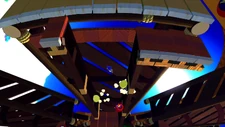
In the Wii U/PC version of the game, Springs come in three different types. Most of the regular and medium-sized Springs possess their modern design and are commonly used for simple transport. There are also extremely large Springs featuring their modern design that are used to move from one section of the Zone to another. This version of the game also has the classic yellow and red Springs from the early Sonic games which may be hidden underground or inside walls.
In the Nintendo 3DS version of the game, two types of Springs appear. The first ones are the regular type of Springs (which possess their typical modern design), and the second ones are the extremely large Springs featuring their modern design that are used to move from one section of the Zone to another. These Springs are sometimes contained inside Cases which will only open after a certain amount of enemies are defeated, or inside large Badniks which will only relinquish them after they are destroyed.
Sonic Mania
![]() In Sonic Mania, and its expansion Sonic Mania Plus, Springs possess their classic yellow and red designs from the Sega Mega Drive games. In this game, the typical Springs are either horizontally, vertically or diagonally aligned, and function much like they did in the first Sonic games.
In Sonic Mania, and its expansion Sonic Mania Plus, Springs possess their classic yellow and red designs from the Sega Mega Drive games. In this game, the typical Springs are either horizontally, vertically or diagonally aligned, and function much like they did in the first Sonic games.
Many Spring-based gimmicks and variants from previous games make an appearance in their exclusive Zones, including Jump Panels, Spring plates that seal up the exit of high-speed warp tubes, and in the center of the high-speed spiral tubes in Chemical Plant Zone; the floating Spring launchers of Stardust Speedway Zone; the depressible green Springs of Oil Ocean Zone; the Springs on wheels of Metallic Madness Zone; and the sideways Springs that pop out of the walls and ground of Titanic Monarch Zone; all of which function like they did in previous games. Flying Battery Zone also features flipping, orange Springs that function like red Springs, much like in Sonic & Knuckles. A new variant of Springs called Ice Springs is introduced in Press Garden Zone Act 2 as well.
Sonic Forces
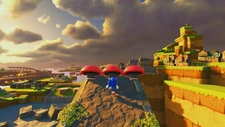
In Sonic Forces, the Springs served again as general gimmicks. In this game, the stages where Classic Sonic is playable feature only the classic yellow and red Springs from the Sega Mega Drive Sonic games, while the stages where Sonic and/or the Avatar are playable only feature the standard modern Springs from the post-Sonic Adventure games.
It is worth noting that the Springs in Classic Sonic's stages, unlike in Sonic Generations and similar to the classic games, work only when the player jumps onto them.
Team Sonic Racing
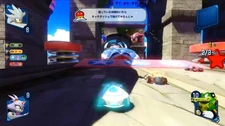
In Team Sonic Racing, the game's wide spring ramps have two giant classic-designed red Springs on both sides of the ramp to indicate to any oncoming racers that the ramp will bounce them upwards and not just launch them forwards like normal ramps do. In addition, Whale Lagoon possess uniquely designed horizontally-placed Springs on one of its walls. These Springs possess the modern Springs' red springboard, but their center is gray and has black ripple patterns on it. If the racer drives too close to a wall with Springs, they will be bounced toward the right side of the race track.
Sonic Frontiers
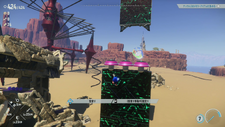
In Sonic Frontiers, Springs appear as gameplay gimmicks in the Open Zone areas and Cyber Space stages.[14][15] In this game, they possess an altered version of their modern design, which sports a glowing blue triangle in place of the star, and a purple exterior. Later in the game, classic designed Springs with both yellow and purplish red panels are also present during the Open Zone gameplay, which cannot be _targeted with the Homing Attack.[16] In Cyber Space stages, the appearance of both types of Springs matches the one from previous games.[17][18]
The Murder of Sonic the Hedgehog
In The Murder of Sonic the Hedgehog, the Classic yellow Springs appear during the "DreamGear" levels, and also during the battle against the Mirage Express. Like in previous games, if Sonic steps on a Spring, he will be sent flying. Most of the time, Springs appear before large bottomless pits, but may also appear over a large row of spikes. Usually, these gimmicks lead the player to a Super Ring Item Box. However, they can also cause them to skip large groups of Rings at times.
Sonic Dream Team
Other game appearances
Sonic Jam
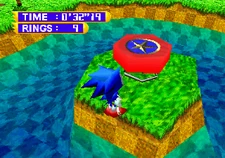
In Sonic Jam, the Spring retain their overall classic design and possess a red color scheme. Much like in the Sega Saturn version of Sonic 3D Blast, the Springs' panels are emblazoned with a gold star in the middle of a blue circle.
In gameplay, the Springs only appear in Sonic World, which has two Springs that send the player into midair.
Sonic the Hedgehog Pocket Adventure
![]() In Sonic the Hedgehog Pocket Adventure, the Springs appear with their classic design. In this game, yellow and red Springs reappear, all of which are aligned either horizontally, vertically or diagonally. Some Spring-based gimmicks from Sonic the Hedgehog 2 also appear, including Jump Panels and Spring Catapults.
In Sonic the Hedgehog Pocket Adventure, the Springs appear with their classic design. In this game, yellow and red Springs reappear, all of which are aligned either horizontally, vertically or diagonally. Some Spring-based gimmicks from Sonic the Hedgehog 2 also appear, including Jump Panels and Spring Catapults.
Sonic Jump series
Sonic Jump (2005)
In Sonic Jump, the Springs are designed as round red panels with a gray spring underneath them. In addition, their panels have a blue center in their middle.
In this game, the Springs float around in midair on red platforms and always come in vertically-aligned pairs. In some cases, the Springs even move left and right.
Sonic Jump 2
In Sonic Jump 2, which is essentially a remake of the original Sonic Jump, the Springs look and behave exactly like they did in the original title.
Sonic Jump (2012)

In Sonic Jump (2012), the Springs possess much of their original design, being red panels with a gray spring underneath them. However, these Springs have a raised blue center on top of them and a white line around the edge of their panels.
In this game, most the Springs are vertically aligned. However, some of them may be diagonally aligned as well, and may even send the playable character across a chain of Springs. Also, rather than floating around on their own, the Springs all rest on solid platforms.
Sonic Jump Fever
In Sonic Jump Fever, the Springs look and behave exactly like they did in Sonic Jump (2012).
Super Smash Bros. series
Super Smash Bros. Brawl
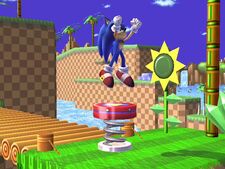
In Super Smash Bros. Brawl, the Spring's design mixes the red Springs from early Sonic games with their design in the 3D Sonic games. Basically, it has the classic red Springs' panel and spring, the Bumper symbol emblazoned on top of it, and a blue line along its side. The Spring's sound effect when jumped on uses the sound effect from the early Sonic games. The size of the spring is also slightly smaller than its original size.
In this game, the Spring appears as a part of Sonic's Spring Jump move. When performing this move, Sonic summons a Spring underneath him and uses it to shoot himself up a great vertical distance. When used on the ground, the Spring remains in place for a while, allowing other characters to use it, too. If this move is used in the air, the Spring falls downwards, acting as a projectile that deals damage and horizontal knockback, making it effective for edge guarding and especially gimping. Also, springing from the ground sends Sonic higher up than when using it in the air. Barring any outside influence, the Spring will remain on the ground long enough for Sonic to do three jumps off of it, disappearing just as he makes his third jump.
Unlike in his home series, Sonic was not able to simply summon springs like he does in Super Smash Bros.; he was only able to locate them in different areas.
If Sonic bounces off a previously set Spring, including his own, it does not count as his third jump as long as he does not land on it immediately from his previous Spring Jump. As such, he can use the Spring Jump immediately afterward, gaining a great deal of height.
Super Smash Bros. for Nintendo 3DS and Wii U
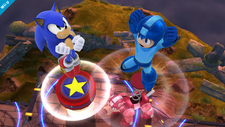
In Super Smash Bros. for Nintendo 3DS and Wii U, the Spring retains its design from Super Smash Bros. Brawl, being a basic red panel with a spring underneath it, the Bumper symbol emblazoned on top of it, and a blue line along its side. The sound effect is still the same from Brawl, even though previous Sonic games, like Sonic Lost World, gave the spring a newer jump sound.
In this game, the Spring appears again as a part of Sonic's Spring Jump maneuver. It also retains its mechanics from Super Smash Bros. Brawl. The Nintendo 3DS and Wii U instalments also feature additional variations of the Spring Jump that the player can customize Sonic with (which in turn affects the Spring):
- Spring Jump (Default): Spawns a spring. When used on the ground, it sticks around and can be used by anyone.
- Double Spring: Doesn't spring as high, but the move can be used twice in a row without landing.
- Springing Headbutt: Spring straight up and deliver a headbutt. The spring doesn't stick around, though.
Super Smash Bros. Ultimate
In Super Smash Bros. Ultimate, the Spring possesses the same design it had in the previous Super Smash Bros. installments, giving it a classic red Spring look with the Bumper symbol emblazoned on top of it and a blue line along its side, as well as the same sound effect. In this game, the Spring appears again as a part of Sonic's Spring Jump technique.
Sega Superstars Tennis
In Sega Superstars Tennis, Springs can be seen in the background of the Green Hill tennis court.
Mario & Sonic series
Mario & Sonic at the Olympic Winter Games
In the Wii version and Nintendo DS version of Mario & Sonic at the Olympic Winter Games, the Springs possess their standard, modern design.
In the Wii version of the game, the Springs make an appearance as ornaments during the first and second segment of the Sonic World version of the Dream Figure Skating event, where they are used by the playable character to gain elevation for their tricks.
In the Nintendo DS version of the game, Springs are featured in all the routines for the Ultimate Figure Skating event. Here, the Springs appear within star icons and when utilizing one, the player has to execute a number of Real-Time Interactions. The player can perform a total of three jumps from each Spring to collect all of the Rings above them. Springs also appear in the Fever Hockey event, where they are mounted on the sides of the ice rink to serve as obstacles that will knock the hockey puck off-course. The Springs also appear in the game's Adventure Tours mode. Here, Sonic has the ability to use Springs, although Mario cannot, to traverse the different environments in the mode's hub worlds.
Mario & Sonic at the Sochi 2014 Olympic Winter Games
In Mario & Sonic at the Sochi 2014 Olympic Winter Games, the Springs possess their modern design, but with a yellow line around the edge of their panels added to it. In this game, the Springs appear in the Roller Coaster Bobsleigh event where they are used to jump between segments of the race tracks. When sent flying by Springs in this event however, the player usually has to use the Wii U GamePad to match the angle of the sled with the angle of the ground when about to land. The Springs also appear during the Sonic's Figure Skating Spectacular event as ornaments, where they are used by the playable character to gain elevation for their tricks.
Mario & Sonic at the Rio 2016 Olympic Games
In the Nintendo 3DS version of Mario & Sonic at the Rio 2016 Olympic Games, the Spring are given their classic design from the Sega Mega Drive games. In this game, an very large classic red Spring appears in the Long Jump Plus event. Here, when the player reaches the event's take off line, press ![]() to make the playable character jump onto the Spring. The playable character will achieve a greater distance the closer they get to the takeoff line. Jumping too early however will make the playable character fail to reach the Spring. Jumping too late on the other hand will cause the character to receive a foul. If the playable character successfully lands on the Spring though, the player must wait for it to assume a 45 degree angle, at which point they have to press
to make the playable character jump onto the Spring. The playable character will achieve a greater distance the closer they get to the takeoff line. Jumping too early however will make the playable character fail to reach the Spring. Jumping too late on the other hand will cause the character to receive a foul. If the playable character successfully lands on the Spring though, the player must wait for it to assume a 45 degree angle, at which point they have to press ![]() to make the playable character launch from the Spring. Notably, the closer the Spring gets to a 45 degree angle, the further will the playable character jump. Should the player initiate the jump too early or fail to initiate the jump at all, the playable character will be launched from the Spring, but there will only be recorded a small distance for the attempt.
to make the playable character launch from the Spring. Notably, the closer the Spring gets to a 45 degree angle, the further will the playable character jump. Should the player initiate the jump too early or fail to initiate the jump at all, the playable character will be launched from the Spring, but there will only be recorded a small distance for the attempt.
Mario & Sonic at the Olympic Games Tokyo 2020
In the Nintendo Switch version of the Mario & Sonic at the Olympic Games Tokyo 2020, the Springs possess their modern designs from post-Sonic Adventure games.
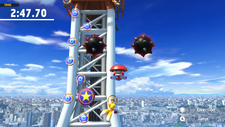
In gameplay, the Spring appears as a power-up in the Dream Karate event. In this event, the Spring will fall into the arena from above when its associated tiles in the arena are stepped on. It can then be picked up by the playable characters. However, the playable characters will drop the Spring when they pick up another item or get knocked down. Flying Springs kept in midair with propellers on their bottoms also appear as gimmicks in the "Tower Climb" mini-game. Here, they can be used to take shortcuts along the climbing wall in the mini-game.
Sonic & Sega All-Stars Racing
In Sonic & Sega All-Stars Racing, the Whale Lagoon race course has horizontally-placed Springs on the walls. If the racer drives way too close to a wall with Springs, they will be bounced towards the right side of the race track.
Sonic Dash
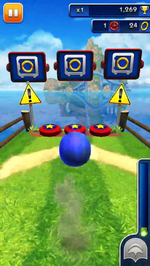
In Sonic Dash, the Springs possess their modern design. In this game, they are used by the player to mark the transition between the sections of the running segments. They will also initiate a banking procedure and a Trick sequence whenever they are used.
The Springs are located in rows of three at the end of the running routes, with a floating icon above each of them which indicate a special feature they each grant:
- Ring icon: Let the player earn Rings while they are sent flying.
- Shuttle loop icon: Has the player enter a small do-or-die Real-Time Interaction.
- Whale statue icon: Sends the player from the grass route to the stone bridge route of Seaside Hill.
- Totem pole icon: Brings the player back to the grass route.
Sonic Runners series
Sonic Runners
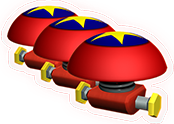
In Sonic Runners, the Springs all possess their modern design. In this game, Springs come in two types: regular Springs, which are larger than normal and aligned either vertically or diagonally, and the Support Springs/Spring Platforms.[19] The latter is a booster-class item that the player can either obtain from an Item Box marked with a Spring icon in the Stages or equip beforehand for 1,000 Rings, which temporarily sets up a string of Springs across bottomless pits to prevent the player from falling into them.
Sonic Runners Adventure
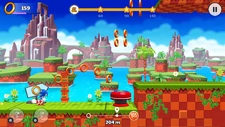
In Sonic Runners Adventure, the Springs are referred to as Jump Springs.[20] In terms of design, they resemble their counterparts from the 2012 remake of Sonic Jump, each being a red panel with a gray spring underneath it, a white line along their lower edge, and a raised top section on their panels with a yellow star inside a blue circle emblazoned on it.
In this game, the Springs only appear as regular gimmicks, meaning there are no Spring Platforms. There are also some Springs that are used for the transection between the different sections of the levels.
Sonic Speed Simulator
In Sonic Speed Simulator, the Springs possess their standard, modern design. They are colored bright red and have a blue circle with a yellow star in the center on their tops. In this game, the Springs are featured in all playable Worlds as a means to traverse the environment and reach vending machines or Sky Rings. The game also featured wide springs, which serve the same purpose.
Variants
Blue spring
The blue spring is a variant of the Spring that looks almost the same as the regular modern Spring, but blue instead of red. When the player gets bounced through midair by one of these Springs, the player must complete a Real-Time Interaction to make the bounce perfect or risk a premature fall. They only appeared in the Xbox 360/PlayStation 3 version and Wii/PlayStation 2 version of Sonic Unleashed.
Color panel
The color panel is a type of Spring that is designed like a digital circuit board. Despite the different look though, the color panels function just like regular Springs. It is worth noting, however, that only a select few of them work like Springs. They only appeared in Shadow the Hedgehog.
Egg Spring
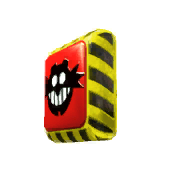
The Egg Spring is a Spring variant that works in opposition to the player. Should the player hit these Springs, they will bounce the player backwards or off-course. They also play a short, high-pitched laugh after the playable character hits them. They first appeared in Sonic Unleashed.
Ice Spring
![]() The Ice Spring is a type of Spring that is made of ice. Usually found inside breakable ice cubes, these light blue Springs act like the classic yellow ones, but after they are used they evaporate and cannot be used again. They first appeared in Sonic Mania.
The Ice Spring is a type of Spring that is made of ice. Usually found inside breakable ice cubes, these light blue Springs act like the classic yellow ones, but after they are used they evaporate and cannot be used again. They first appeared in Sonic Mania.
Jump Panel
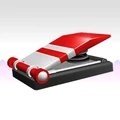
The Jump Panel is a variation of the Spring that resembles a springboard. It essentially combines the Dash Panel and the Spring. Running into a Jump Panel will result in the player being sent flying straight ahead without having to stop. They first appeared in the 16-bit version of Sonic the Hedgehog 2.
Mobile spring
The mobile spring is a yellow variant of the wide spring with three-setter Springs. Like yellow Springs in the first games, the mobile springs bounce the player less higher than the red ones. Also, after touching a mobile spring, it starts auto-scrolling and the player usually has to balance on it. It only appears in the Wii version of Sonic Colors.
Pogo Spring
The Pogo Spring is a power-up based on the Spring. It allows the player to move around with a Spring equipped to the playable character's feet and use it to reach higher areas. Once the player jumps off the Pogo Spring however, they will lose it. They only appeared in Sonic Chaos and Sonic the Hedgehog Triple Trouble.
Propeller Spring
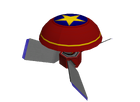
The Propeller Spring is a Spring-based gimmick with a propeller beneath it. These Springs can raise themselves higher into the air if the playable character continuously lands on their spring panel. However, they cannot maintain their increased height if the player does not bounce on them fast enough. They first appeared in Sonic Adventure 2.
Special Spring
![]() The Special Spring is a unique type of Spring. These springs are slightly bigger than the average Spring and can be used to get to their game's respective Special Stage. They only appeared in Sonic Advance and Sonic Advance 3.
The Special Spring is a unique type of Spring. These springs are slightly bigger than the average Spring and can be used to get to their game's respective Special Stage. They only appeared in Sonic Advance and Sonic Advance 3.
Spring Catapult
The Spring Catapult is a type of Spring designed for pinball sections. In gameplay, they are used to load a player's pinball (which is a playable character) and then launch it into a nearby pinball section. They first appeared in the 16-bit version of Sonic the Hedgehog 2.
Spring Pole
The Spring Pole is a bar-based Spring. They are presented as flexible poles, usually hanging on walls, and the playable characters can launch themselves higher into the air by bouncing on them. Sometimes, the player has to bounce multiple times on them to reach the desired destination. They first appeared in Sonic the Hedgehog CD.
Thorn Spring
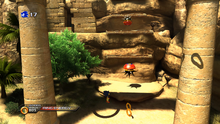
The Thorn Spring is a dangerous Spring variant. These Springs have spikes on their bottom and flip around in intervals. They will thus harm the player should they dare to touch them while their spikes are up. They first appeared in Sonic and the Secret Rings.
Wide Spring

The wide spring is an extended version of the Spring. As the name implies, it features three bumper-based Springs side by side on a plate. Wide springs are easier to connect with during fast-paced gameplay and always bounce the player straight upward.
In other media
Animation
Adventures of Sonic the Hedgehog
In the Adventures of Sonic the Hedgehog television series, a grey Spring appears in "Tails Prevails". This one was activated by Dr. Robotnik, who used it on Scratch and Grounder after they told him about Tails' knowledge of machinery. The Spring bounced them to the roof, where they got trapped due to a magnet.
Sonic the Hedgehog the Movie
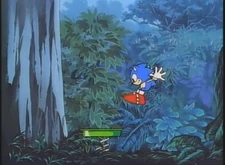
In Sonic the Hedgehog: The Movie, a single Spring appears briefly. During Sonic and Tails' trek towards Robotropolis, Sonic used a green Spring at one point to fly a vertical cliff.
Sonic X
In the Sonic X anime series, Springs are mechanisms that are found on Earth.
Sonic Prime
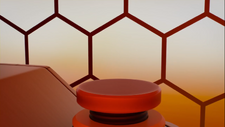
In the Sonic Prime television series, springs are common objects. In this show, they use designs very similar to the ones they had in the Classic games, and lack the Bumper symbol usually emblazoned on top.
Books and comics
Sonic the Comic
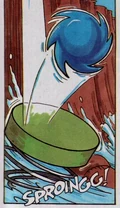
In the Sonic the Comic series published by Fleetway Editions, Springs are positioned all around Mobius. Like in the games, the user can archive incredible heights when using them. They only appeared in the early stories of the series, however, and are shown with a different color scheme each time.[21] One time, Sonic and Amy used a Hyper-Spring to get to the Floating Island.[22]
Archie Comics
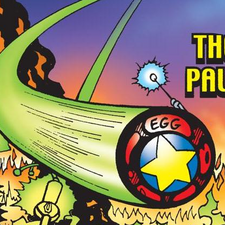
In the Sonic the Hedgehog comic series and its spin-offs published by Archie Comics, Dr. Eggman created a floating Spring as part of Hunter's weaponry. It was a basic red, yellow and blue Spring with the word "EGG" in the upper corner and an antenna on top of it. Hunter used this Spring against Sonic the Hedgehog to bounce the hedgehog all over the place while he dealt with Knuckles. After Knuckles went Hyper Knuckles and defeated Hunter though, the Spring was shut down.[23]
IDW Publishing
In the Sonic the Hedgehog comic series and its spin-offs published by IDW Publishing, Sonic would use the Spring underneath Vista View to reach the surface to fight the Egg Hammer.[24]
Trivia
- In the 8-bit games, most of the Springs are actually drawn in the level layout itself instead of being sprites because of the low sprite limit of the Sega Master System and the Sega Game Gear; because of this, they are not animated unlike their 16-bit counterparts. Furthermore, their color is likely to change according to the palette of the level they are placed in. For example, the Springs in Sonic the Hedgehog 2 (8-bit)'s Under Ground Zone are gray, while the ones in Sky High Zone are green. Despite the sprite limit, in Sonic Chaos and Sonic the Hedgehog Triple Trouble a Spring object exists. These Springs are normally invisible, hidden in the ground or on the top of a palm tree or other scenery elements, and they pop up, complete with the springing animation, when the playable character comes in contact with them. Due to the high number of color variations, the springs pictured below do not cover all the kinds existing in the 8-bit games.
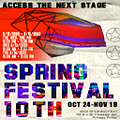
- On Earth, Springs are not mentioned in the storylines, but they are featured as devices created by humans and has advertising. In City Escape in Sonic Adventure 2, there are posters which advertise a "Spring Festival". With there being both an image of a Spring and a date of 24 October to 18 November, it is safe to assume this is not referring to the season.
- A leftover model of the Spring from Sonic Jam can be found in data of Sonic Adventure.
- In an early screenshot of Sonic the Hedgehog (2006), anyone can notice that the concept design of the Spring is the same as in Sonic Heroes.
- Springs made a cameo appearance in Samba De Amigo for the Wii, but they look different. The top is made of two parts which are held together by a metal clasp.
- In episode 23 of the Digimon Adventure anime, the sound effect for the regular Spring can be heard, when Digitamamon raises one eyebrow.
- A couple of episodes from the Iznogoud animated series also used the Spring sound effect occasionally.
See also
References
- ↑ Sonic Colors (Wii) United States instruction booklet, pg. 16.
- ↑ Sonic World Adventure (Xbox 360) Japanese instruction booklet, pg. 15.
- ↑ 3.0 3.1 Sonic Unleashed (PlayStation 3) United States instruction booklet, pg. 15.
- ↑ 4.0 4.1 Sonic the Hedgehog (Sega Genesis) United States instruction booklet, pg. 7.
- ↑ 5.0 5.1 5.2 Prima Publishing (1993). "Sonic The Hedgehog for Sega Genesis". Sonic the Hedgehog 1 & 2: Sega's Official Player's Guide. Prima Publishing. p. 13. ISBN 1-55958-335-5.
- ↑ Sonic the Hedgehog (Sega Game Gear) United States instruction booklet, pg. 9.
- ↑ Sonic the Hedgehog CD (Sega CD) United States instruction booklet, pg. 16.
- ↑ Sonic Drift. The Green Hill Zone. Retrieved on 12 November 2018.
- ↑ Sonic Drift Racing (Sega Game Gear) United States instruction booklet, pg. 14.
- ↑ Sonic Drift 2 (Sega Game Gear) Japanese instruction booklet, pg. 22.
- ↑ Sonic Adventure online. Amy Rose tactical info: Hot Shelter. Archived from the original on 5 June 2016.
- ↑ 12.0 12.1 Sonic Advance 2: Prima's Official Strategy Guide. Prima Games. 11 March 2003. p. 21. ISBN 978-0761540083.
- ↑ Sonic Unleashed (Xbox 360) United States instruction booklet, pg. 13.
- ↑ Sonic Team (8 November 2022). Sonic Frontiers. Xbox One. Sega. Area/level: 1-1. "Homing Attack and Springs: If a _target cursor is shown on a Spring, do a Homing Attack by pressing
 . Try attacking them to pull off a huge jump!"
. Try attacking them to pull off a huge jump!"
- ↑ Sonic frontiers full demo first play through EGX. YouTube (27 September 2022). Retrieved on 28 September 2022.
- ↑ Sonic Frontiers - 6 Minutes of Chaos Island Gameplay. YouTube (24 October 2022). Retrieved on 26 October 2022.
- ↑ Sonic Frontiers - Nintendo Direct Mini: Partner Showcase | 6.28.2022. YouTube. Nintendo (28 June 2022). Retrieved on 28 June 2022.
- ↑ EGX Sonic Frontiers Gameplay 2. GreenHill 2D footage. Big Cyberspace Gate Footage. YouTube (24 September 2022). Retrieved on 29 September 2022.
- ↑ SONIC RUNNERS [SEGA]. Sega. Retrieved on 19 November 2018.
- ↑ Gameloft (10 June 2017) Sonic Runners Adventure. Android. Sega. Area/level: Green Hill. "Hint: When you jump onto a Jump Spring, you can reach higher areas!"
- ↑ Sonic the Comic #4, "Day of the Badniks"
- ↑ Sonic the Poster Mag #6, "Marble Garden Menace"
- ↑ Sonic the Hedgehog #141 "Return to Angel Island Part Four: Ultimate Hero"
- ↑ Sonic the Hedgehog Annual 2020, "Big's Big Adventure".
External links
- Spring at the Sonic the Comic Wiki.